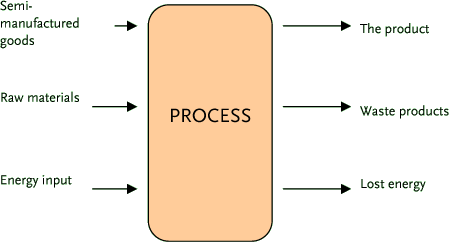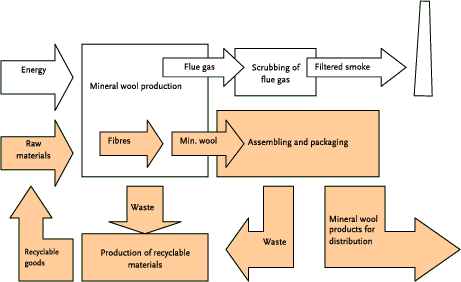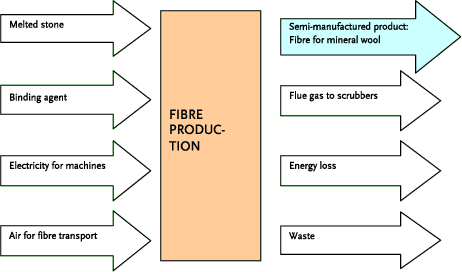Guidelines for the Inclusion of Environmental Aspects in Product Standards
2 Correlation between Product Standards and Environment
Product standards determine requirements for the manufacture, content and mode of operation of products. As all manufactured goods influence the environment in one way or another, product standards can influence the environmental impact of a product.
The great variety of products manufactured by modern industry and the huge numbers in which these goods are produced means that the products – and thereby also the product standards – influence the environment.
Even though a product standard may only apply to a single aspect in the product’s life cycle e.g. its dimensions or the use of certain materials, this has an influence on the product’s entire life cycle from the extraction of raw materials to the disposal or release of the product to the environment. Some of the influences a product standard can have on the life cycle of a product are mentioned in Fig. 2.1 below.
It is important to analyse a product through its entire life cycle when determining environmental requirements in a product standard.
Figure 2.1: Examples of the environmental impact of product standards
- Standards for thermal insulating materials:
When a standard sets requirements for an insulating material's insulating properties it will have an effect on the materials which can be used, the amount of different materials that can be used and the method of production. In this way the standard influences the extraction of raw materials and the production phase, as well as the environmental problems that may arise in connection with these processes. The standard will also have an influence on the amount of energy saved due to the use of the isolating material in a building during the application phase.
- Standards for concrete:
When a standard for concrete allows for the use of flue ash and other reclaimed materials it plays a role in solving the problem of depositing these residues. If the flue ash contains environmentally hazardous materials in large amounts e.g. heavy metals, one should be aware of the fact that leaching of the hazardous materials in the application phase or depositing phase can lead to environmental problems.
This chapter gives a short introduction to CEN’s environmental checklist, which is CEN’s method for undertaking an initial analysis of a product’s environmental impact. After this an introduction is given to a more detailed life cycle assessment of a product. This is followed by concrete examples of life cycle assessment.
2.1 CEN’s environmental checklist
CEN has developed an environmental checklist for use in work with product standards. The checklist is based on the principles of Life Cycle Assessments (LCA). The objective of the environmental checklist is to create a comprehensive overview of a product’s impact on the environment throughout its entire life cycle. CEN’s environmental checklist is a “screening tool” that highlights the most important environmental impacts in a product’s life cycle, thereby focusing on the environmental aspects that should be taken into account when determining a product standard. It is compulsory for standardising bodies to use the environmental checklist when developing new standards and revising old standards.
The environmental checklist is shown in Fig. 2.2 below. The main phases in a product’s life cycle (production, distribution, application and deposition) extend from the one axis, whilst environmental issues extend from the other axis. Apart from the immediate environmental parameters (discharge to the atmosphere, discharge to water, refuse, noise, migration of substances and soil pollution) other environmental aspects are also considered such as use of resources (resource and energy consumption) and accidents.
The environmental checklist is used by marking the fields where the individual environmental parameters are relevant e.g. with crosses or yes/no. The distribution of the number of crosses or yes/no will give an indication of where the most important environmental problems occur.
It may happen that a product gets crosses in many or all of the fields. In such situations it is necessary to prioritise according to criteria determining the importance of each environmental aspect in order to reduce the number of crosses.
It is often the case that the technical experts sitting on standardisation committees know the product and method of manufacture so well that they can complete such an environmental checklist immediately. In cases of uncertainty or disagreement the completion of the checklist should be done after consultation. If necessary life cycle assessments can be made in varying detail to reach an outcome. CEN Environmental Helpdesk can also provide assistance as can CEN’s homepage.
The checklist can be expanded to include, amongst others, working environment and indoor climate. The individual life cycle phases can also be divided up into sub-phases if required.
Fig. 2.3 below provides an example of CEN’s environmental checklist completed by an environmental ad hoc group under CEN Technical Committee 88 on thermal insulating materials. The objective of the ad hoc committee's work was to complete initial considerations of the environmental aspects associated with thermal insulating materials. CEN TC 88 could then concentrate on the environmental issues that should be incorporated into the revision of the standards under the jurisdiction of TC 88. The environmental ad hoc group decided to limit the completion of the checklist to mineral wool products.
Figure 2.2: CEN's Environmental checklist
| Environmental aspects |
LCA-phases | ||||
| Production of raw materials |
Production | Distribution | Application | Deposition | |
| Use of resources | |||||
| Energy consumption | |||||
| Discharge to the atmosphere | |||||
| Discharge to water | |||||
| Refuse | |||||
| Noise | |||||
| Migration of substances | |||||
| Soil pollution | |||||
| Accidents | |||||
The ad hoc group marked the fields in the checklist with a "yes" where it was felt that there were important environmental impacts and "no" where it was felt that the environmental aspects were not substantial and, therefore, should not be included in further considerations.
As indicated on the checklist, the ad hoc group determined that the most important environmental impacts connected with thermal insulating materials are linked to energy consumption and discharge to the atmosphere. It is especially the manufacturing and deposition phases that have the most serious environmental impacts. It is not evident from the checklist that some of the environmental effects of the products are positive e.g. the products have a large energy saving and noise reducing effect in the application phase (2.D and 6.D), which give a positive environmental impact.
The environmental ad hoc group compiled a more detailed report, which explains the decision behind each marked field.
Figure 2.3: Example of a checklist for a product (mineral wool products for thermal insulation prepared by TC 88 ad hoc committee for environmental issues)
| A. Pre- production including transport of the raw materials |
B. Production |
C. Distribution and installation (including packaging) |
D. Use |
E. End of life |
|
| 1. Natural resource use | Yes | Yes | No | No | Yes |
| 2. Energy consumption | Yes | Yes | Yes | Yes | Yes |
| 3. Emissions to air | Yes | Yes | Yes | Yes | Yes |
| 4. Emissions to water | Yes | Yes | No | No | Yes |
| 5. Waste | Yes | Yes | Yes | No | Yes |
| 6. Noise: nuisance | No | No | Yes | Yes | No |
| 7. Effect on soil (land use) | Yes | Yes | Yes | No | Yes |
| 8. Risks from accident or misuse | Yes | Yes | No | No | No |
2.2 How to make a life cycle assessment
The concept of life cycles is central to the environmental assessment of products. Due to this most international standardising bodies have accepted life cycle assessments as a general principle in environmental assessments in connection with product standardisation. A short introduction to the principles of life cycle assessments as well as a few examples follows.
A product's life cycle is typically divided into the following phases:
- Production of raw materials
- Manufacture
- Distribution
- Application/use
- Recycling
- Deposition.
A product's principle life cycle is illustrated in Fig. 2.4 below.
Figure 2.4: The principle steps in a product's life cycle

In reality a product's life cycle is much more complicated than the above mentioned seven phases. There can be many more links in the life cycle as well as many "off shoots" as semi-manufactured goods are assembled to form one complex product. Due to this transportation often occurs between the various phases, which can be relevant for the overall environmental assessment. Various forms of recycling can also mean that residual products are returned to the life cycle.
All the individual phases can, in principle, be considered as input/output processes where raw materials or semi-manufactured goods enter at the one end and new products and waste products emerge from the other end. All processes require the input of energy and there will, therefore, always be energy that goes to waste in one way or another, which should be considered in the overall assessment. The input/output model is illustrated in Fig. 2.5 below.
Inputs and outputs can have very different characteristics. An input can, for example, include both raw materials such as water and clay as well as energy in the form of electricity. Outputs can, therefore, include waste materials as well as wasted energy. The product can be either a semi-manufactured good or the final product depending on where in the life cycle the product occurs. Waste products can be either solid waste, emissions to the atmosphere such as smoke or wastewater. Wasted energy is the energy that is made available during a phase of production but which is not used in the process. This could be residual heat for example, which could be used for central heating instead.
If the "process" is the sandblasting of a steel mast, which will later be painted then the semi-manufactured product is the steel mast, the raw material is the sand used in the sandblasting and the energy is the electricity used to blast the sand against the mast. On the output side the product (which is still only semi-manufactured) is the sandblasted steel mast. The waste product is the contaminated sandblasting sand, which can be clean and reused. The waste energy is the heat released from the sandblaster.
Figure 2.5: Input-output model for a process in a products life cycle

Over and above the more traditional material and energy flows other environmental impacts may have to be analysed. Effects such as noise, impact on biodiversity and others are more difficult to analyse, but in some cases these impacts may be the most important so one should be careful not to narrow an environmental assessment down to much from the start.
If one of the products being considered is, for example, made of lumber from tropical rainforests one of the most important environmental aspects may be the loss of biodiversity in the forest from which the lumber originates, while other environmental parameters such as toxic emissions may be of lesser consequence.
Perpetual substances such as heavy metals once released, in principle, circulate infinitely in the environment. During their course in the environment they are taken up by organisms (plants, animals, humans) and thereby have a negative effect. As one cannot follow a substance in the environment through all eternity it is necessary to limit how far one will follow a product's environmental impact in an environmental assessment.
The environmental impact of an output is determined by a number of different conditions, such as:
- How much is discharged (amount)
- How long and when do discharges occur (time/season)
- Where substances are discharged and how they are spread (place)
- What is the recipient environment (recipient).
Some environmentally damaging substances occur in natural cycles, such as CO2. The environmental impact is due to disturbing the natural balance of the cycle (e.g. greenhouse effect). Other products are manmade e.g. pesticides, and if these are persistent they will impact on the environment and its organisms at many levels and over a long period of time.
2.3 Examples of analyses of environmental impacts
In Fig. 2.6 below an example of a simplified flow diagram for a mineral wool product’s journey through the manufacturing process, including the recycling of waste products. After distribution, the completed product will generally be used in the building sector where it will remain for many years. There is usually a certain amount of wastage during the application/use phase, which can be deposited, sent to waste disposal or returned to the factory for recycling. After use the product is generally sent to waste disposal or returned to the factory as recyclable waste.
Figure 2.6: Example of a simplified flow diagram for mineral wool in a mineral wool factory

The aim of producing a flow diagram of the relevant product is to create a comprehensive overview of which processes the product is subject to as well as which inputs and outputs are applicable for the various processes.
Using the principle of ”what is put in must come out again” will give a control mechanism to ensure all inputs and outputs are accounted for. If something is not accounted for then it is necessary to investigate further to find the cause of the problem. Depending on the delimitations of the problem it may be necessary to analyse the steps before and after the relevant process in order to form an overview of a greater part of the life cycle.
Using a flow diagram also helps create a picture of which outputs are released to the environment, and thereby the material and energy flows that influences the environment. Furthermore flow diagrams are useful when limiting the scale of a life cycle assessment where many material and energy flows have to be taken into account. Flow diagrams also make it easier to determine where environmentally hazardous substances are in the production process and how they are handled.
In Fig. 2.7 below a more detailed input/output model of the central process in Fig. 2.6, viz. the manufacture of mineral wool is shown. Such a description allows for an in depth analysis of inputs and outputs according to the principle of “what goes in must come out again”.
Figure 2.7: Example of a simplified input/output model for the manufacture of mineral wool

When working in environmental aspects it is the outputs that occur directly to the environment and the inputs that originate from natural resources that are of the greatest interest.
For many construction products such as mineral wool, the application phase is relatively simple as the products are enclosed in the building and carry out their intended function, viz. thermal insulation. Other building materials require regular cleaning and maintenance and will, therefore, have a number of inputs and outputs associated with their application phase. If the environmental analysis includes the entire building then mineral wool insulates the structure and thereby plays a role in reducing energy consumption in the building. This will in turn play a role in reducing the environmental impact (inputs and outputs) related to energy consumption of the building. When looking only at the environmental impacts of mineral wool it is in the manufacturing and deposition phases that lead to the greatest environmental impacts.
For other products e.g. washing machines and cars a different pattern forms. For these products it is the application phase that has the most important inputs and outputs that impact on the environment. For cars it is especially exhaust gases that cause the greatest environmental impact. For washing machines it is inputs such as water, electricity and soap powder that directly and indirectly pose the greatest environmental problems. The discharge of wastewater on the output side also creates a considerable negative environmental impact. Even though there are important inputs and outputs, and therefore also environmental impacts, during the production of the above mentioned products these are overshadowed by those that take place during the application phase.
Version 1.0 August 2006, © Danish Environmental Protection Agency